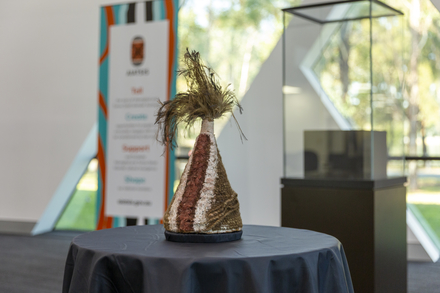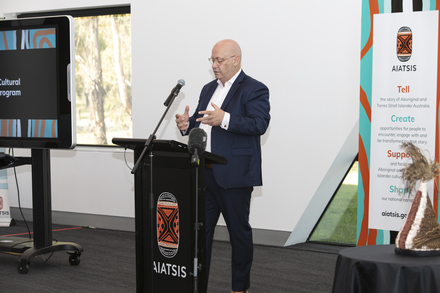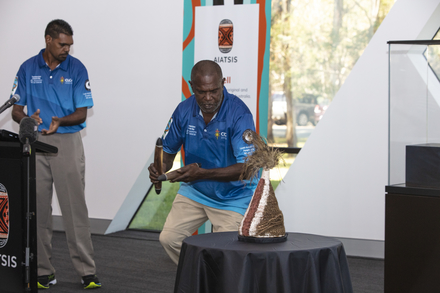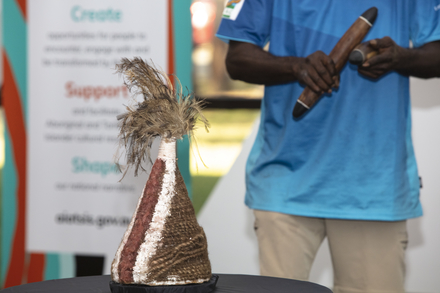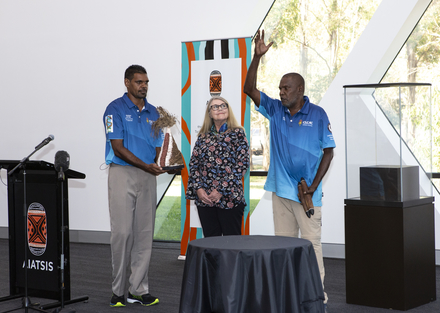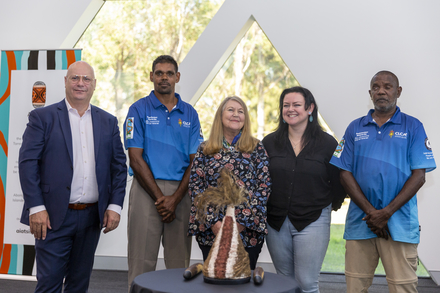A ceremonial headdress that has returned from half way around the world was formally received by representatives of the original custodians, the Lardil people of the Gulf of Carpentaria, at a ceremony in Canberra today.
Some 50 years ago the headdress was used in public performances by the late Mr Philip Jack, a member of the Lardil Dancers (known as the Mornington Island Dance troupe) that performed at the 1973 opening of the Sydney Opera House. It is made of a cone of bark, wound with a string of human hair, painted with ochre and adorned with emu feathers.
Lardil are the Traditional Owners of Gununa (Mornington Island) and other islands within the Wellesley Islands in the Gulf of Carpentaria, Queensland. There is a strong history of performance and visual art and craft on Gununa, with Lardil men continuing to wear such headdresses during ceremonial occasions.
Mr Jack gave the headdress as a farewell gift to Mr Maurice Routhan, his neighbour in Sydney, as Mr Routhan prepared to return to the UK in the 1970s. In recent years, Mr Routhan has sought a way to send the headdress back to where it belongs.
‘I was very proud to be given this gift when I left Australia, and I'm even more proud to be able to hand it back,’ he said in a video message from his home in East Sussex that was shown at today’s event.
Accordingly, Mr Routhan’s family in Australia explored means for repatriating the headdress. Following initial efforts to find a way to transfer it to Gununa, in July 2020 Mr Routhan’s daughter Dr Sharon Rundle contacted the Return of Cultural Heritage team at AIATSIS.
After much careful preparation, the Lardil headdress arrived back in Australia in late January and was received into the care of AIATSIS in mid-February, pending advice on the next step from the Wellesley Islands Community.
The representative organisation for the Lardil, Yangkaal, and Kaiadilt peoples is the Gulf Region Aboriginal Corporation (GRAC).
‘This headdress is a special men’s ceremony hat that represents the totem of the Rainbow,’ Lardil representative Lawrence Burke said at the return event.
‘Only a lawman can wear this one. This return is important because Mr Jack was an elder, a cultural man, a law man, and an important song man for this place.’
The Minister for Indigenous Australians, the Hon Ken Wyatt AM, spoke of the importance of such heritage items.
‘Today is a significant moment for the Lardil people of the Wellesley Islands community,’ Mr Wyatt said.
‘Aboriginal and Torres Strait Islander cultures are kept alive by the passing of knowledge, arts, ceremonies and performances from one generation to another, and importantly protecting sacred and significant sites and objects such as this one.
‘The Morrison Government’s support of the Return of Cultural Heritage Initiative, which facilitates and secures the return of Aboriginal and Torres Strait Islander cultural material from overseas to Australia, makes returns such as the one to day of the Lardil headdress from England possible.’
AIATSIS CEO Craig Ritchie said that the movement to identify and return cultural heritage items is gaining international momentum, and has special relevance for Australia.
‘For over 250 years Australia’s First Nations cultures have drawn attention from many parts of the world,’ Mr Ritchie said. ‘Materials representing important cultural heritage have travelled far from their homes.
‘There is a challenging task in identifying such material, in negotiating its return, and then in shipping and storing it safely ahead of handing it over to the rightful custodians. But that effort is embraced by AIATSIS. The repatriation of national treasures further demonstrate the depth and diversity of First Nations cultures in this country – cultures that predate most other civilisations.’
Dr Sharon Rundle has monitored every step of the journey of the headdress from her father’s home.
‘It was when we heard from the Lardil people and the Wellesley Islands Community through GRAC that we understood the significance of the headdress and what it means to them to have it returned,’ Dr Rundle said at today’s event.
‘I urge anyone who wishes to return Aboriginal and Torres Strait Islander artefacts to contact AIATSIS. If you are in possession of an artefact and haven’t thought about returning it, please do and be assured that it will be a significant gesture and that the artefact will be treated with great respect and care.’
